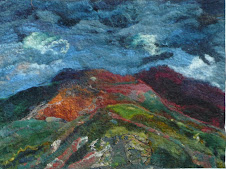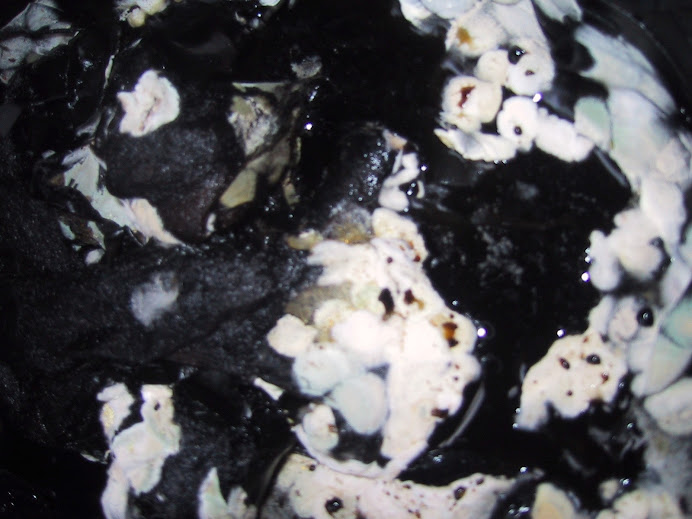On Friday 30th August I ripped the leaves up and covered with 3 litres of boiling water and left to stand
Two hours later I squeezed out the leaves and the liquid was a very dark tea colour and at pH 5.89.

I added 1 tablespoon of washing soda, the pH went to 9.18 and the liquid to a dirty slimy green.
After beating for 3-4minutes there was a faint blue scum on the surface
I added 1/2 tablespoon of washing soda and brought it up to 9.59. ( This was to replicate the vat I did with the students which was a rather high pH but worked)
The foam went a slight turquoise blue in a few places . But dear oh dear where was the deep blue foam I had expected. :(

I beat for another 2/3 minutes but there was no change to the foam
I added 1 teaspoon of Thiourea dioxide and put the plastic bowl inside another bowl to which I added hot water. The vat was a nice hand hot 50 degrees C.


I expected to find that this amount of fresh Isatis Indigotica would have dyed 100 g of wool much deeper blue. Leena had the most fantastic result with her persicaria (polygonum) Tinctoria the Japanese Dyer knotweed and I was hoping for something similar!
The dogs and I went off for a walk to think about this. Provided the dogs are well behaved this I find is a good thinking time. Then I had a light bulb moment when I remembered that Enys and her DH only manure and dig over the bits where the vegetable are grown and don't feed the areas where the dye plants and the the herbs grow. I know they have not been watered with a nitrogen feed which mine have and I felt that one of the reason for the weak vat was the fact that the plants had not been fed., woad ( isatis Tinctoria)was/is notorious for needing rich well manured soil and I assume the chinese variety would be the same. I also think that the pH was too high for wool. I find that wood dyes best at pH 8.5-9 and at a hand hot temperature.
Here is another experiment . Remember? Back in the days , at the beginning of July ,when we thought we might have a sunny summer I put this out in my sunny spot. 
The tannin bearing plants which with iron quite quickly went black. The fibres on the top of the jar went black ( well until I washed them but the bottom ones stayed white). Here is the result.

Might have been better with the sun on the jar!



























It's interesting (and not unsurprising really) that external factors play such an important part in the results obtained from natural dyeing.
ReplyDeleteI guess consistency of results is why many people prefer chemical dyes.
Helen, your blues from the comment before are phantastic! I think I do need your booklets after all:) alternatively you could send me all your blue fibres:) I haven't had time to pick my polygonum yet, but I don't think a few more days will make a difference - it's in the polytunnel anyway. but of course it's disappointing, when you have hopes to repeat those stunning results and it doesn't work the way you expected it. the downside with natural dyes is that you sometimes put a lot of work in - and don't get what you want. but on the other hand - the stunning results (when they come:) make up for it? if all else fails you might be able to overdye the lighter blues?
ReplyDeleteHi Sue I just love the excitement of getting a good colour so I learn to live with the poor one! On the whole I can use whatever colour I make or as Bettina points out overdye them . I did have a very frustrating trying to get madder red for a commission last winter and nothing I did would give it. But then chemical dyes do not give it either! At least not for me.
ReplyDeleteHi Bettina hope your JP works for you and if you want the books just say so- I have just painted some more indigo covers tonight:) And some 18.5 micronmerino+silk has dyed well if you want to be tempted with some blues. :) :) Bw Helen